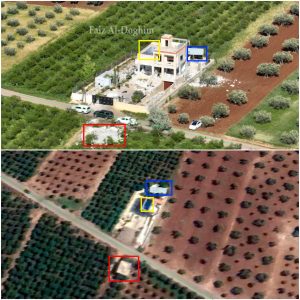The Islamic State (ISIS) has formally announced the death of its leader Abu al-Hussein al-Husseini al-Qurshi, naming Abu Hafs al-Hashimi al-Qurashi as the terror group’s next Caliph.
While brief, the announcement claimed that Abu al-Hussein was killed during “direct clashes” with Hayat Tahrir al-Sham (HTS) militants in Syria’s Idlib Province before turning his body over to Turkey. ISIS did not provide a timeframe as to when this allegedly happened. Turkey, however, announced that he was killed during a Turkish intelligence operation in the Afrin district of the Aleppo countryside back in April.
While ISIS is not particularly fond of telling the truth, either account paints two different pictures and highlights how complex Syria is in regard to extremism.
The HTS Angle:
HTS is arguably the most powerful militant group in Idlib and north-west Syria, which over the past few years has been consolidating its power even further by giving rival jihadist groups operating in the region the ultimatum of joining HTS, dissolving, or being moved out by force. While having historically deep roots to al-Qaeda, HTS has attempted to “rebrand” itself in recent years to be taken off international terrorist lists, especially for Russia, Turkey, and the United States.
That past two years has seen intense crackdowns by HTS on other extremists groups operating in Idlib, such as Hurras al-Din and ISIS cells, which has quickly seen the group become one of the most prominent opposition forces in the country with a heavy presence in Syria’s northwest. It is also speculated that HTS’ increased presence and operations against other Jihadists groups are in an effort to allow them to take part in any political discord about the region and is attempted signaling that they can be a significant long term actor in the region.
Last October, HTS stormed the city of Afrin, which sits in the northwest corner of Aleppo Province and has been controlled by militants of the Turkish-backed Syrian National Army (SNA) since 2018 during Turkey’s Operation Olive Branch. The advancement came as infighting between factions of the SNA left the security situation in the area fragile following the assassination of a well known social figure from the area. Surrounding towns and villages were also captured during this push, including Jindires. HTS eventually withdrew after being given an ultimatum by Turkey.
#Syria ??: Hay'at Tahrir al-Sham (#HTS) militants allegedly took control of #Afrin (in #Aleppo Governorate) from #TFSA.
Videos show HTS moving in their vehicles including T-55 main battle tank, BRM-1(K) and BMP-1 infantry fighting vehicles (IFVs) —originally captured from #SAA. pic.twitter.com/PwTQLv9Hks
— War Noir (@war_noir) October 13, 2022
The dynamic between HTS and Turkey is complicated. While Turkey has designated HTS as a terrorist organization, HTS has been doing much of the work Turkey has sought to do in the region by flushing out militant groups and creating stability in Idlib under Turkey’s joint agreement with Russia. Due to this, Turkey has been accused of secretly supporting the group with unofficial approval and not interfering with their operations, even when against Turkish-backed militant groups.
The Middle East Institute explained that “Ankara’s belated and weak reaction to HTS’s recent advances speaks volumes,” adding that “By violently blocking the “Peace Caravan,” a campaign of 400 people marching toward the Bab al-Hawa crossing en route to Europe via Turkey in September, HTS demonstrated its willingness to prioritize Ankara’s interests. Furthermore, HTS’s brief advance into southern Afrin in June and its subsequent compliance with the Turkish withdrawal order, which was interpreted by some as a challenge to Turkish influence in northern Syria, sent a clear message to Ankara that it could be relied upon.”
Likewise “The remaining challenge for Turkey, however, is how to instill lasting stability in a region full of unaddressed grievances among the different SNA factions. While HTS could provide security and governance in these areas in the long term, its local legitimacy will remain questionable.”
With all of this being said, if Abu al-Hussein was killed in Idlib by HTS, one could speculate it was done so on their own accord considering their track record of targeting ISIS. Likewise, HTS could have used it as a way to show Turkey that they can be a reliable faction in the region. Despite this, however, HTS never made any announcements about killing ISIS leadership.
Turkey Angle:
Turkish President Recep Tayyip Erdogan announced during an interview with TRT Turk on March 1 that Abu al-Hussein was killed the day prior in Aleppo, Syria, during an operation carried out by MIT (Turkish National Intelligence Organization). This marked the third ISIS emir to be killed in just over a year.

Photos of Abu al-Hussein’s alleged hideout following the operation were geolocated to a home near the city of Jinderes. Since 2018, the area has been under the control of the Turkish military and its allied Syrian rebel forces. While exact details still remain unclear, clashes took place and ended with al-Qurshi allegedly killing himself by detonating a suicide vest.
#Afrin: SOHR: The #ISIS leader that was killed by Turkish-occupation in occupied Cindirês yesterday, called "Abu Hussein al-Qurashi", was a leader in "Ahrar al-Sharqiya" terrorists. pic.twitter.com/XlbcEnkW8q
— Rojava Network (@RojavaNetwork) April 30, 2023
If Abu al-Hussein was killed in Aleppo by Turkish intelligence, it begs the question as to how he was able to plant himself there. As stated above, the area has been under the control of the Turkish military and the SNA since 2018 during Operation Olive Branch. While the SNA opposes ISIS, the group has faced accusations of recruiting former ISIS members into its ranks, presenting the possibility that Abu al-Hussein’s presence was known, but not acted on.


